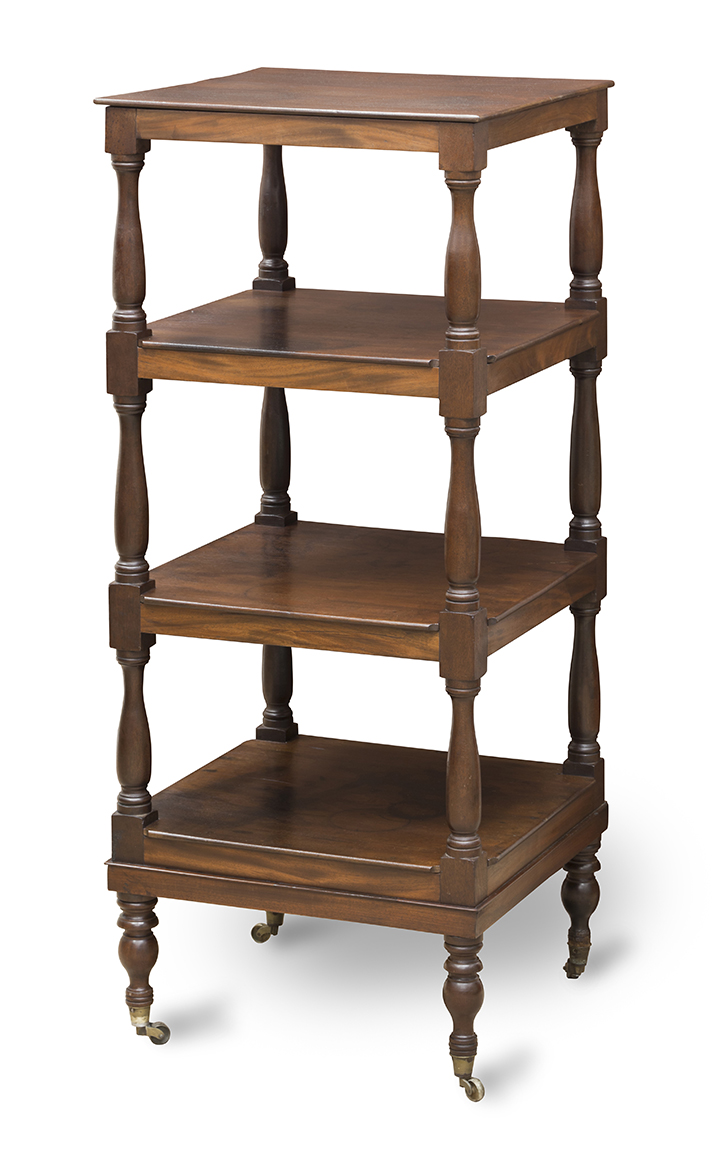Dumbwaiter
Well Turned Posts & Feet
Mahogany & Mahogany Veneers
Richmond, Virginia
Circa 1800-1820
48” x 20” x 19 ¾”
Commentary: While dumbwaiters were not introduced into American dining rooms by Thomas Jefferson, he did bring the form and style of dining to the White House and probably popularized it in and around the new District of Columbia. Jefferson had apparently enjoyed the informal style of dining that the dumbwaiter facilitated during the years he had lived in France while serving as American Minister and continued the practice as President – not without some controversy. Margaret Bayard Smith described Jefferson’s practice as follows:
When he had any persons dining with him, with whom he wished to enjoy a free and unrestricted flow of conversation, the number of persons at the table never exceeded four, and by each individual was placed a dumbwaiter, containing everything necessary for the progress of the dinner from beginning to end, so as to make the attendance of servants entirely unnecessary, believing as he did, that much of the domestic and even public discord was produced by mutilated and misconstructed repetition of free conversation at dinner tables, by these mute but not inattentive listeners.
Jefferson purchased at least four dumbwaiters in Philadelphia after his return from France (possibly from Henry and Joseph Ingle) and may have put these into service at the White House. The informal and self-consciously more “democratic” style of dinners favored by Jefferson proved quite a contrast to the diplomatic and social customs that had been practiced by his predecessors and offended some of his more traditionally minded contemporaries – including the British ambassador. After his retirement from public life to Monticello, Jefferson continued the use of dumbwaiters in his dining room there and at his home Poplar Forest in Bedford County. He had at least two dumbwaiters made in his Monticello joinery, presumably by his enslaved cabinetmaker John Heming. His use of this form was undoubtedly emulated by the wealthier neighbors and acquaintances in the area.
Without doubt Jefferson’s custom of incorporating dumbwaiters in his dining room would have influenced the practices of his friends and neighbors in the Virginia piedmont. Our example has a history in the Howardsville area of Albemarle County only a few miles from Monticello. Settled in the eighteenth century, principally by Virginians moving up from the lower James to plant new lands with tobacco and other crops in the 1730s and 1740s, Howardsville area residents included the Andersons, Jordans, Cabells and Childresses. During the early years of the 19th century, the community grew into a prosperous small town, which was enhanced by its location at the confluence of the James and Rockfish Rivers and the construction of the James River and Kanawha Canal.
Situated at the falls of the James River, Richmond was geographically, politically, economically and socially Virginia’s foremost city at the outset of the nineteenth century. It was certainly the most convenient and logical source of fashionable furniture for the rural areas up the river to the west and its cabinet shops would have been well known to planters in these regions. The turnings of our dumbwaiter with their flattened “milk bottle” profile are characteristic of those found in other Richmond furniture from the period.
Early European forms were often elaborate pieces of furniture of rosewood, mahogany or japanned and gilded but their use was not widely adopted in America in the eighteenth century. Sheraton described the dumb-waiter in his Cabinet Directory as a “useful piece of furniture…[of which] There are different kinds…all made of mahogany, and intended for use in the dining parlor, on which to place glasses of wine, and plates, both clean and such as have been used.” The most common American examples, particularly those dating to the late 19th century, are tripod tables with a central pedestal, usually with tray tops or rims. Few dumb waiters of the form or quality of our example have survived.
Condition: The dumbwaiter is constructed of mahogany posts with complex turnings that are joined by yellow pine rails with mahogany veneers. The mahogany shelves are shaped to accommodate the posts and finished on three sides. The upper shelf, which has an old repaired split, is secured by modern wood glue blocks. The original nails that secured all of the shelves to the rails have been removed to allow natural shrinkage and movement and prevent further stress on the panels. Two of the four casters are original. The old surface shows ring stains, heat scorching and other blemishes commensurate with age and use. Several coats of varnish were padded on and a wax surface brought up by conservators at the F. C. Vogt Company of Richmond in 2013.
Price: SOLD


